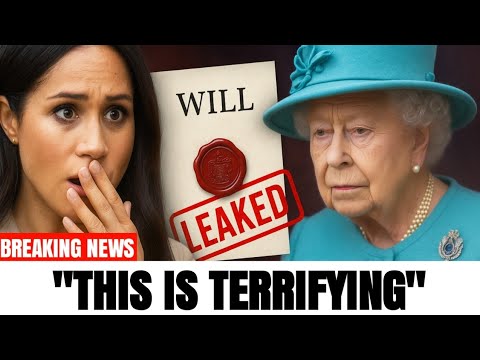QUEEN’S SECRET WILL LEAKED WHAT SHE LEFT MEGHAN SHOCKS THE WORLD

The biggest thing that I know is that I—I never thought that this would be easy, but I thought it would be fair. In her final will, Queen Elizabeth gave Meghan Markle exactly nothing except the plate. The late Queen’s secret will has finally come to light, and it’s sending shock waves through royal insiders. While other members of the royal family receive lands, heirlooms, and centuries-old treasures,
Meghan Markle was reportedly left out entirely. No jewels, no trust fund, no property—just a single royal banquet plate, seen by many as a chilling message: You were never truly one of us. What does the symbolic snub really mean? Was it personal, political, or both? And why did the palace work so hard to keep this detail buried? Stay with us. What you’re about to hear may change how you see Meghan, the Queen, and everything in between.
Before we continue, please hit the like button, subscribe to the channel, and turn on the notification bell for updates. It was the moment the world had been quietly bracing for—the unsealing of Queen Elizabeth II’s private will. While the state affairs and ceremonial transitions had moved forward swiftly following her passing, the contents of her personal final testament remained under strict confidentiality. Until now, weeks of speculation had brewed across royal circles, political corridors, and gossip-fueled tabloid pages about what the Queen might have left behind for each family member.
Jewelry passed down through generations, homes gifted with quiet discretion, handwritten letters sealed in wax—nothing sparked more public curiosity and private tension than what, if anything, had been left for Meghan Markle, the Duchess of Sussex. And then came the stunning revelation. Sources close to the royal estate—including a former household legal adviser and a senior palace aide—confirmed that Meghan Markle had received virtually nothing of tangible value from Queen Elizabeth’s personal estate. No diamonds, no property, no personal letters or recorded messages— not even a token locket or old brooch. Nothing except one single item: a decorative porcelain plate once used for royal banquets, stored in the palace’s collection of ceremonial tableware.
There were no instructions, no explanation, no handwritten note accompanying it—just an item that, by its very selection, screamed meaning or perhaps more accurately sent a silent, but unmistakable, message: You are not part of us. The symbolic weight of that gesture hit harder than any amount of gold ever could. Because, in the rigid and calculated ecosystem of the British monarchy, gestures speak louder than words ever could. But how did it come to this? How did a woman once welcomed into the fold with great fanfare become the singular recipient of what many are calling the coldest royal inheritance in modern history?
Why would the Queen, known for her restraint and fairness, choose to give Meghan, her grandson’s wife, so little—and with such obvious symbolic weight? This story isn’t just about a plate. It’s about a long winding path of public friction, private conflict, and deep-rooted mistrust. It’s about a Queen who lived through eleven British Prime Ministers, navigated the crumbling of empires, survived multiple royal scandals, and yet made one final intimate decision that now threatens to reshape public memory of her relationship with the Sussexes. To understand the weight of this decision, one must first revisit the path that led Meghan Markle from admiration to alienation.
When she entered the royal family, it was with open arms and immense global attention. She was hailed as a modernizer, a biracial American actress with charm, confidence, and a global platform. The wedding was a spectacle of unity, optimism, and progressive values. Yet, within months, things changed. Palace insiders spoke of clashes behind closed doors, protocol disputes, staff turnover, an aggressive public relations campaign from both sides that muddied the waters, and ultimately, a departure from royal duties that sent the monarchy into a defensive spiral. The Oprah interview marked a breaking point. Accusations of racism, emotional abandonment, and institutional cruelty were laid bare for the world to judge. In that moment, lines were drawn, public opinion split, and within the palace walls, relationships fractured in ways that, as now revealed, were never truly repaired. But here’s where the story twists. Queen Elizabeth, despite the turmoil, maintained public neutrality. She rarely made direct




